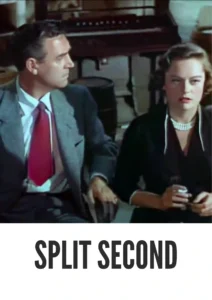Video Sources 0 Views
- Watch trailer
- Split Second 1953 Colorized


Synopsis
Table of Contents
Toggle
Enter a world of Cold War paranoia and suspense with Split Second, a gripping thriller from 1953, now beautifully colorized for a breathtaking viewing experience. Directed by Dick Powell, this film delivers a chilling blend of suspense, crime, and atomic anxiety within the confines of a Nevada test site. Perfect for fans of classic thrillers and those intrigued by the atomic age, this HD download brings a unique and intense piece of cinematic history to your screen. Often known by the alternative title, Atomic Danger, this film will leave you on the edge of your seat.
Split Second plunges viewers into the tense atmosphere of a Nevada atomic testing site. The story centers on Sam Hurley (Stephen McNally), a hardened criminal who, along with his henchman, escapes from prison. They take three hostages: a glamorous singer, Dorothy (Alexis Smith), a professor, and his wife. Seeking refuge in a ghost town, they soon discover they are trapped within a designated atomic test zone.
As the clock ticks down, the group faces not only the immediate threat of Hurley and his volatile temper, but also the impending detonation of an atomic bomb. Tensions rise as they grapple with their mortality and the desperate need to escape before it’s too late. The film masterfully blends the suspense of a crime drama with the terrifying uncertainty of nuclear annihilation, creating a truly unforgettable cinematic experience. Split Second is a thrilling race against time, set against the backdrop of Cold War anxieties.
The film features a stellar cast of actors who vividly bring this suspenseful story to life:
-
Stephen McNally as Sam Hurley
-
Alexis Smith as Dorothy
-
Jan Sterling as Arthur Baker
-
Keith Andes as Larry Fleming
-
Arthur Hunnicutt as “Pop”
Split Second expertly blends genres, falling primarily into the category of a suspenseful thriller with strong elements of film noir and crime drama. Its unique setting and themes firmly plant it within the realm of atomic age cinema, reflecting the anxieties and fears of the Cold War era.
Released in 1953, Split Second reflects the pervasive anxieties of the Cold War and the dawn of the atomic age. The film taps into the public’s growing fears about nuclear weapons and their potential consequences. This era saw the rise of “atomic cinema,” films that directly addressed the threat of nuclear war and its impact on society. Split Second stands out for its effective combination of crime drama with the looming threat of atomic annihilation, making it a compelling reflection of its time.
This colorized version of Split Second has undergone a meticulous restoration process, utilizing cutting-edge digital technology to enhance the visual experience while carefully preserving the film’s original atmosphere of tension and suspense. The colorization process involved in-depth analysis of the original black and white footage, with colors thoughtfully selected to enrich each scene. Advanced algorithms were employed for color palette selection and image enhancement. This painstaking effort breathes new life into the characters and settings, making the story even more captivating for modern audiences. While debates surrounding the colorization of classic films persist, this process introduces Split Second to a broader audience, ensuring its legacy endures for future generations.
-
: Dick Powell
-
: Irving Wallace, Earl Felton
-
: Chester Erskine
-
: Joseph F. Biroc
-
: Robert Swink
-
: RKO Radio Pictures
-
: RKO Radio Pictures
-
: 85 minutes
-
: MP4
-
: HD (1080p)
-
: Compatible with most devices, including smartphones, tablets, computers, and smart TVs.
Split Second (1953) is praised for its taut direction, strong performances, and its ability to capture the anxieties of the atomic age. Critics often highlight the film’s effective use of its Nevada test site setting and its suspenseful narrative. While perhaps not as widely recognized as some other films of the era, Split Second remains a compelling and thought-provoking example of Cold War cinema. Its unique blend of genres and its exploration of timely themes make it a standout film for those interested in the era.
-
: What is Split Second about?
-
A: Split Second is a thriller about a group of people trapped in an atomic test site with a dangerous escaped convict.
-
-
: What are the other titles for Split Second?
-
A: Split Second is also known as Atomic Danger.
-
-
: Is Split Second (1953) a well-known film noir?
-
A: While not as famous as some noirs, Split Second is a notable example of atomic age thrillers, blending suspense with Cold War anxieties.
-
-
: Is this version of Split Second colorized?
-
A: Yes, this version has been professionally colorized to enhance the viewing experience.
-
-
: What makes Split Second interesting for classic film fans?
-
A: Split Second offers a unique glimpse into the fears of the atomic age, combined with a thrilling crime drama narrative.
-
-
: What is the download format?
-
A: The download format is MP4, which is compatible with most devices.
-
-
: What resolution is the download?
-
A: The resolution is HD (1080p), providing a high-quality viewing experience.
-
Watch Split Second Today!










